



The Access to Clean Cooking Energy and Electricity – Survey of States (ACCESS) is India’s largest multidimensional energy access survey conducted across six of the major energy-access-deprived states – Bihar, Jharkhand, Madhya Pradesh, Odisha, Uttar Pradesh, and West Bengal. The study conducted by the Council on Energy, Environment and Water (CEEW), with support from the Shakti Sustainable Energy Foundation and the Lee Kuan Yew School of Public Policy National University of Singapore, covered more than 9,000 households from 756 villages in 54 districts collecting about 5 million data points. The results from the first round of the study, ACCESS 2015, highlighted the need to look beyond connections to enable rural India’s access to modern forms of energy. In 2018, we revisited the households to understand the changes in their energy access situation over the last three years, and to study the impact of government policies during this period. The study analyses energy access for households using a multidimensional, multi-tier framework. Households are assigned tiers on the basis of their level of access to energy. Tier 0 indicates the lowest level of access and Tier 3, the highest.
Access to electricity: key findings
Since ACCESS 2015, the proportion of rural households connected to the grid has gone up by 20 percentage points (and is rapidly increasing further). But we observe a steeper (32 percentage points) increase in the proportion of households relying on grid electricity as their primary source of lighting. Further, and even better, we observe a 35 per centage point jump in the share of households experiencing electricity access at the level of Tier 1 or above.
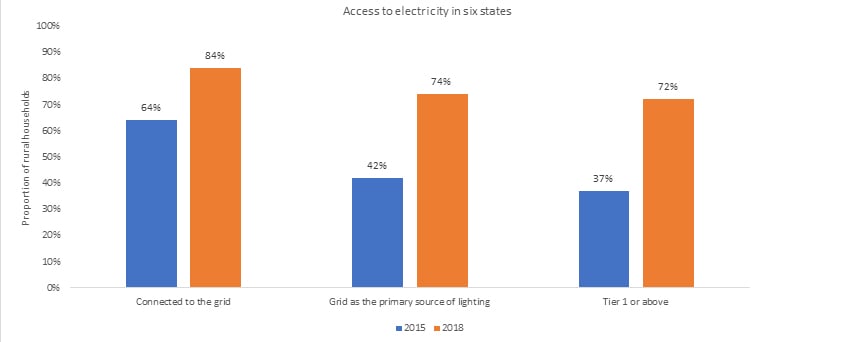
Source: CEEW analysis, 2018
Over the last three years, the proportion of households using kerosene as a primary source of lighting has reduced substantially from 53 per cent to 20 per cent. Though the situation has improved in all the states, there are still 30 per cent or more rural households in Uttar Pradesh and Jharkhand that rely on kerosene for meeting their primary lighting needs.
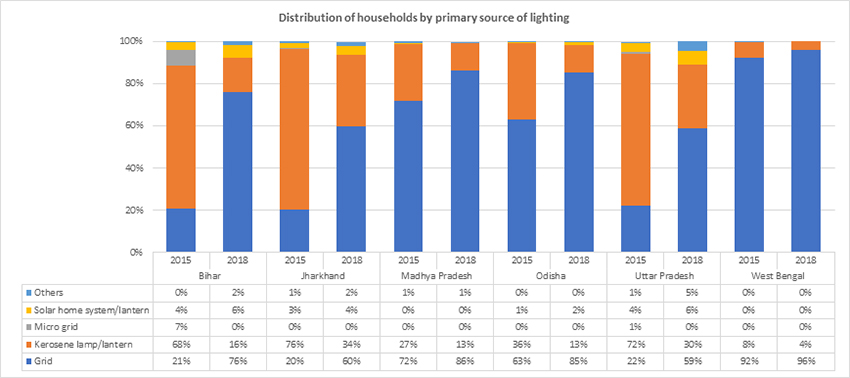
Source: CEEW analysis, 2018
When viewed from a multidimensional, multi-tiered perspective, Bihar, Jharkhand, Madhya Pradesh, and Uttar Pradesh have experienced a considerable reduction in the proportion of households in Tier 0, with a commensurate increase in the proportions of households in higher tiers. The steep decrease in the proportion of households categorised as Tier 0 in Odisha has been accompanied by an increase in the proportions of households in Tiers 2 and 3. A noticeable share of households in West Bengal have actually slipped from higher tiers to lower tiers.
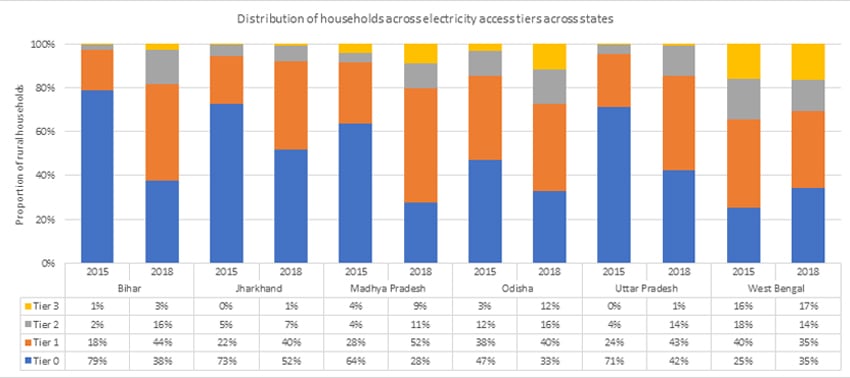
Source: CEEW analysis, 2018
The median hours of daily supply in the six states combined has increased from 12 to 16 hours over the last three years. In Bihar and Madhya Pradesh, which have shown the most improvement, the supply duration has increased from 8 to 15 hours and 12 to 18 hours, respectively. Jharkhand recorded only a modest increase in its median hours of power supply, from eight to nine hours per day.
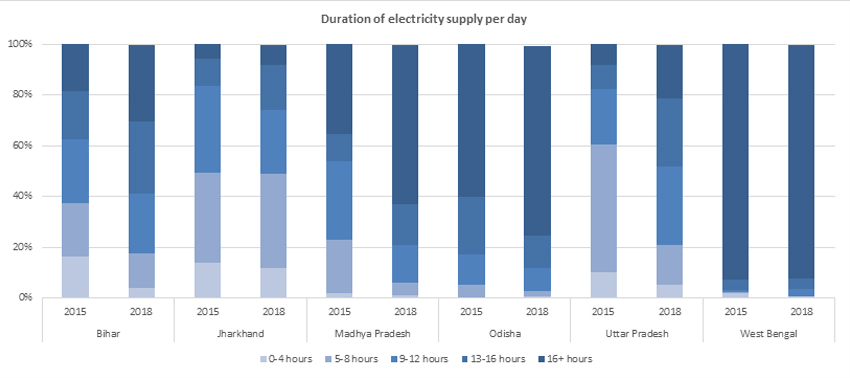
Source: CEEW analysis, 2018
The median number of day-long blackouts in a month has decreased from two days to one day at the aggregate level for the six states, indicating an overall improvement in the reliability of power supply. While this number has reduced in five states, it has increased from zero to two in West Bengal. Also, the proportion of households reporting zero blackout days has decreased in the state, from 53 to 30 per cent, indicating a deteriorated state of electricity reliability in West Bengal.
On an average, the supply quality has improved. About 29 per cent of households reported at least one day in a month with incidence of high voltage (which damages the appliances), down from 39 per cent in 2015. About 43 per cent of households reported at least one day in a month with incidence of low voltage (which limits the use of appliances), reducing from 52 per cent in 2015.
The proportion of electrified rural households with metered connections has increased from 53 per cent in 2015 to 65 per cent in 2018. However, the disparity among the states continues. While almost all rural households in West Bengal with grid electricity connections have meters, in Jharkhand, this is true for only 21 per cent of such households.
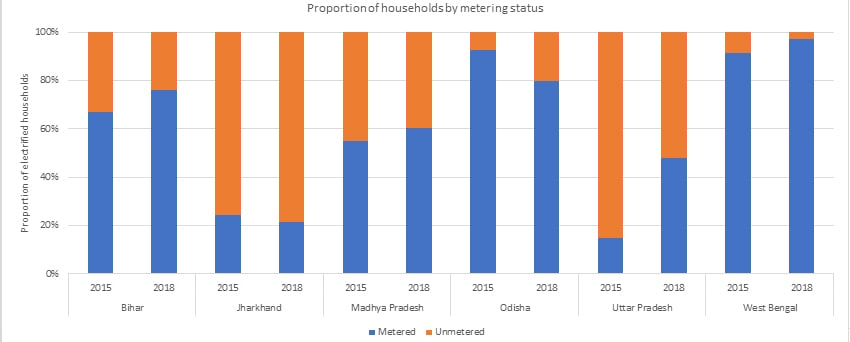
Source: CEEW analysis, 2018
When asked how frequently they received bills for electricity use, about 30 per cent of the households said that they had either not received a bill in the past year, or ever. Of these households, 45 per cent had been electrified only in the past year, indicating that issues related to bill generation affect new and old connections alike.
Of the unelectrified households, 65 per cent mentioned high connection costs as one of the barriers. This is despite the roll-out of Saubhagya, under which connections are to be extended at no upfront cost or on an instalment basis. Further, around 60 per cent of households reported high recurring expenses as one of the barriers for getting a grid connection.
Surprisingly, 14 per cent of unelectrified households said they would prefer not to be connected to the grid even at zero upfront cost. This proportion is as high as 20 per cent in Uttar Pradesh. The preference to remain unelectrified, at least legally, might be due to a reluctance to formalise an existing illegal connection, or a genuine lack of ability to afford regular consumption of electricity, inability to pay lumpy and consequently high-value bills, lack of awareness about how electricity access could help improve the households’ living experience, or unreliable state of electricity supply.
For more details on the ACCESS study, please contact: [email protected].